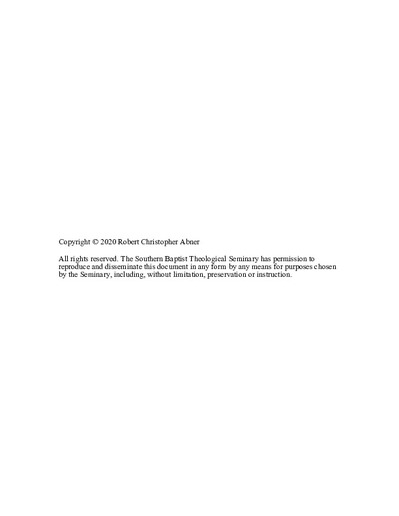| dc.contributor.advisor | Terry, John Mark | |
| dc.contributor.author | Abner, Robert Christopher | |
| dc.date.accessioned | 2020-05-13T19:13:39Z | |
| dc.date.available | 2020-05-13T19:13:39Z | |
| dc.identifier.uri | https://hdl.handle.net/10392/6082 | |
| dc.description.abstract | ABSTRACT
AN EMBRYONIC ECCLESIOLOGY ENABLING CHURCH PLANTING MOVEMENTS TO FLOURISH
Robert Christopher Abner, PhD
The Southern Baptist Theological Seminary, 2019
Chair: Dr. John Mark Terry
This dissertation proposes an ecclesiological rubric for evaluating church planting strategies and methods. The result of these evaluations will be establishing churches that flourish where they are planted. A flourishing church grows and matures to become everything God intends for a church to be rather than settling for minimal expectations for maturity and health.
Chapter 1 introduces the thesis that an embryonic ecclesiology is a necessary component for biblically faithful church planting methodologies. The thesis identifies the issue of ecclesiology on the mission field. Those who are planting churches should be experts on knowing what the church is.
Chapter 2 provides a biblical ecclesiology leading to a rubric for evaluating ecclesiology implicit within church planting strategies. The rubric guides church planting teams to evaluate strategies and methods upon biblical principles for the ontological reality of the church.
Chapter 3 presents an overview of the CPM paradigm and its influence upon current church planting practices. David Garrison is most often associated with CPM paradigms due to his writings. His paradigm and methods will be evaluated using the rubric for evaluating embryonic ecclesiology proposed in chapter 2.
Chapter 4 presents an overview of the church planting method called T4T. T4T is a church planting method influenced by the paradigm and principles of CPM. This method will be introduced and described. The description will include a presentation of its development and specific tactics. Finally, T4T is evaluated by the ecclesiological rubric proposed in chapter 2.
Chapter 5 presents an overview of the church planting method called The Big One. This method is influenced by the paradigms and principles of CPM. The description will include a presentation of its development and specific tactics. Finally, the method is evaluated by the ecclesiological rubric proposed in chapter 2.
Chapter 6 summarizes the lessons learned from this study. Both the strengths and weaknesses of CPM influenced methods are presented. Needed corrections to CPM approaches enabling church plants to flourish are presented. Finally, the proposals for utilizing the rubric developed in chapter 2 is provided. | en_US |
| dc.subject.lcsh | Church--Biblical teaching | en-us |
| dc.subject.lcsh | Church development, New | en-us |
| dc.title | An Embryonic Ecclesiology Enabling Church Planting Movements to Flourish | en_US |
| dc.type | Electronic dissertation | en_US |
| dc.type | Text | |
| dc.contributor.committee | Allison, Gregg R. | |
| dc.contributor.committee | Martin, George H. | |
| dc.type.qualificationname | Ph.D. | en_US |
| dc.publisher.institution | Southern Baptist Theological Seminary | en_US |
| dc.publisher.department | School of Missions and Evangelism | |

